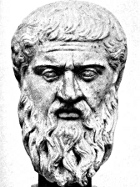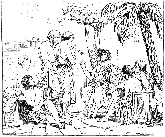Platonism · 4226 dagen geleden by Ad van den Ende
Summary of volume I, § 14 to §18 of The Mechanization of the World Picture, written by E.J.Dijkstehuis
Plato
The things we perceive are only imperfect copies of ideal forms or ideas which in a suprasensible world lead an independent existence. This world can only be approached by pure thought. Before being united to the body the soul did acquire knowledge of the ideal forms through contemplation. This knowledge is still present, though in a dormant state. The dialectic method brings this knowledge back to our conscousness. (…) what seemed to be an acquisition of fresh knowledge is actually only recollection (anamnesis).
That’s why science benefits more from a direct application of mathematical reasoning than from an empirical examination. Results, achieved by thought, can not be verified exactly in the material sphere.
In his diaologue ‘Timaeus’ Plato sets before astronomers the methodological problem to detect in the confused irregularity of the motions of the planets the ideal marhematical system of uniform circulair motions. This system represents the true facts of the processes in a mathematical sky, and thus saves the empirical phenomena from the verdict of unreality that seems to be invited by their irregularity. This problem was to dominate theoretical astronomy for twenty centuries.
16. (…) a benevolent Demiurg has formed the universe from a chaos of primordial matter, as an image of an eternal world of forms …. The considerations that governed him were of a mathematical nature.
17. Plato’s corpuscular theory of matter was an evolution related to the theory of Democritus. The corpuscles are limited parts of a primordial matter, invested only with the qualities of extension in space and impenetrability. Physical phenomena are accounted for by means of these elementary corpuscles.
But Plato’s corpuscles appear not to be indivisible. They have been cut out of spatial matter by polyhedra. These polyhedra are composite structures: they consist of two kinds of right-angled triangles. The elementary corpuscles may break up into these constituent triangles. These may be combined again into polyhedra.
Plato and his disciples
18. (…) the whole spirit of the ‘Timaeus’ is diametrically opposed to that of the Atomist’s world-picture. Whereas in their view both the genesis of the universe and the events taking place in it remained subject to blind chance, in the ‘Timaeus’ a benevolent and wise Demiurg transforms a chaos into an orderly cosmos; whereas the Atomists regarded the life of gods and men as a special variety of the universal mobility of the atoms, Plato makes the cosmos a living being by investing the world-body by a world-soul; whereas the Atomists had no answer to the problems of the existence and purpose of the universe, the ‘Timaeus’ accounts for both: the goodness of the Demiurg would not let Him allow Chaos to persist in the state of disorder in which He found it, and induced Him to transform chaotical spatial matter into a fair whole, which was to be as like Himself as possible.
In some periods the ‘Timaeus’ was thought to contain the supreme knowledge about nature.



